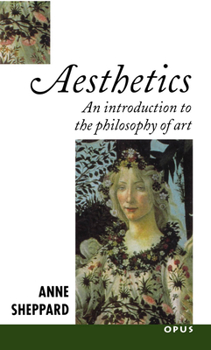Aesthetics: An Introduction to the Philosophy of Art
Why do people read novels, go to the theater, or listen to beautiful music? Do we seek out aesthetic experiences simply because we enjoy them--or is there another, deeper, reason we spend our leisure time viewing or experiencing works of art? Aesthetics, the first short introduction to the contemporary philosophy of aesthetics, examines not just the nature of the aesthetic experience, but the definition of art, and its moral and intrinsic value in...
Format:Paperback
Language:English
ISBN:B00DTS8TNA
ISBN13:9780192891648
Release Date:December 1987
Publisher:Oxford University Press
Length:192 Pages
Weight:0.38 lbs.
Dimensions:0.6" x 5.2" x 7.7"
Customer Reviews
3 ratings
Understand the Philosophy of Art
Published by Thriftbooks.com User , 15 years ago
I read this book for a graduate seminar on the philosophy of art. Anne Sheppard's "Aesthetics, An Introduction" is an excellent text to get a general idea of the vast field of philosophy of art. Aesthetics = philosophy of Art, thinking about art. Originally, aesthetics just meant "sense experience," and had nothing to do with art. A certain theory of art came to co-opt this word. So, much of modern philosophy of art turned more to the subject and away from the object because modern science did such to convince us that the objective world could be understood as a precise matter of mathematical physics. This idea became so impressive that people were making claims about art or ethics similar to science, that we can't make any objective claims about the world, we are simply making claims about human beliefs. So, the turn to the subject becomes common because of the success of modern science it co-opted the discussion of objective nature. We say things about art, but not all are true. The Ancient Greeks had absolute beliefs about art like "beauty." Sheppard finds that how we engage art today is different then how the ancient Greeks did, art was embedded in a cultural context for them. Art was not in museums or in dance halls. Art is in a special zone of experience today in museums, etc. Tragedy for Greeks was part of their politics and religion, sculpture and painting the same way. Music until recently, (after the enlightenment) was for religion or some kind of official function. Philosophy tries to come up with theories about art; it may be a fool's errand. A set of principles that define and illuminates or explains the full measure of art is probably not attainable. However, just because a theory is wrong doesn't mean it has no value, we can draw import from all of them. Thus, Sheppard asks, can art even satisfy necessary or sufficient conditions? One will always find exceptions. A "Necessary condition" is a condition that must be present in order to account for the subject in question, i.e., all art must have X. "Sufficient conditions" are considered to being all that is needed to be in account for the subject in question. Another word a complete sufficient condition means you have captured all that you need to account for. An example of a necessary condition and necessary conditions need not be sufficient conditions, so for instance a necessary condition for "being a bachelor is being a male," but it is not a sufficient condition because you have to have an "unmarried male" in order for it to be a sufficient condition for being a "bachelor." So both "unmarried and male" are necessary conditions, they both must be present in order to account for "bachelorhood," but neither one alone is a sufficient condition because it is not enough. So, when we are trying to define art and one finds some necessary conditions like some kind of "human intervention" that is a necessary condition, but maybe it is a sufficient condition if
A perfect fit
Published by Thriftbooks.com User , 19 years ago
I inherited use of this text as the preferred text for the aesthetics portion of a course on Truth, Beauty, and Goodness. Since I chose Quine's "Web of Belief" and the Kenny Reader on Wittgenstein for the section on Truth, so that students can engage the contemporary issues associated with truth from an overall perspective and actually do philosophy via the extraordinarily subversive energy of Wittgenstein's questions, the Sheppard text fits perfectly as the text that frames the issues over aesthetics in a way that demonstrates the lessons learned from the first two books. This is also short enough to cover the main issues quickly so that there is time left for goodness at the end of the course!
Great, but pricy introduction
Published by Thriftbooks.com User , 19 years ago
Check this out if you're looking for a concise and well-written introduction to the philosophy of art. The author explores why we feel art is so important, what makes 'good' art, and major ideas concerning art as introduced by other philosopher.(...) It's 154-pages, paperback, and has several b & w photos of paintings referred to in the text.






